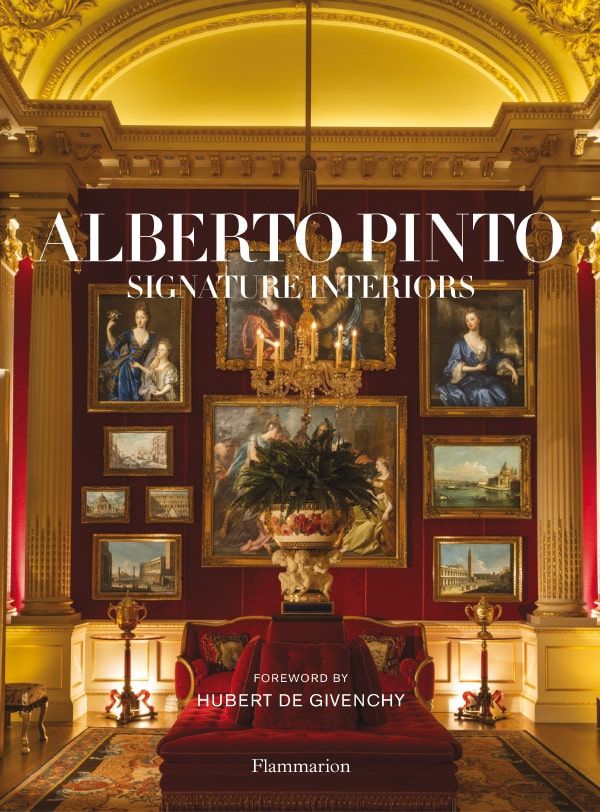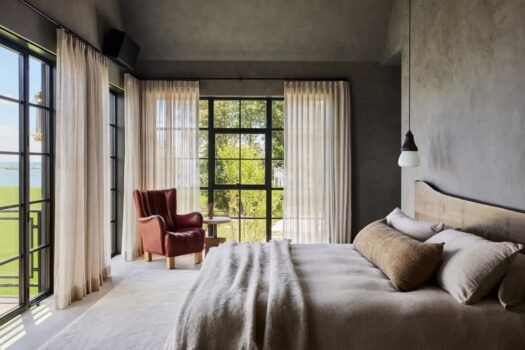
Alberto Pinto by Studio Harcourt. © Alberto Pinto Agency
If you want proof that “some are born to sweet delight,” as William Blake once augured, look no further than interior designer Alberto Pinto (1945–2012). Seldom does one come across a life so charmed. What he accomplished during his 41-year career of wild, wondrous creation — the extraordinarily opulent yet restrained decoration of palaces, villas, pieds-à-terre, townhouses, corporate headquarters, yachts, jets and hotels — is more than most of us might ever dream. What’s most remarkable about it all is that he had no professional training, although every aspect of his cosmopolitan life seems to have been a preparation for his adored vocation.

The mistress of the house’s boudoir in a Marrakech home. Photo by Jacques Pépion
Born in Casablanca to globetrotting Argentine parents of Sephardic Jewish descent, he spent much of his childhood traveling to glamorous and exotic places with them and his younger brother, Charles, and baby sister, Linda, with whom he was extremely close — and who now runs his studio. His love of art, beauty and decorative splendor, especially the rich, complex sort everywhere on view in Morocco, ultimately led him to study art history and world cultures as a young man at the École du Louvre in Paris.
Not surprising for such a budding aesthete, Pinto loved to take pictures. He was also ambitious, and he moved to New York in the 1960s to work as a photographer for Condé Nast. Soon, he was traveling the world shooting fabulous interiors. He was especially inspired by projects he photographed in Mexico by Luis Barragán and in England by David Hicks, and he thought about trying his own hand at interior design while still in his 20s.

Rob Wynne’s Glass Drops sculpture is displayed on the walls of this London townhouse. Photo by Jacques Pépion
He was encouraged in this pursuit by his close friend, the celebrated fashion designer Hubert de Givenchy, himself a once precocious talent and a renowned decorative-arts connoisseur. In Alberto Pinto: Signature Interiors, recently published by Flammarion, Givenchy writes in the foreword about Pinto’s bold first effort: a grand, supremely elegant apartment he designed for himself with “superb furniture (including two Ming cabinets) giant palm trees . . . and an immense hall lined with azulejos,” or Spanish painted tiles. The apartment was also a calling card for Pinto, whose “success was immediate,” as Givenchy notes.
In 1971, he founded Cabinet Alberto Pinto, housed in a suitably stunning 17th-century hôtel du particulier on Place des Victoires (visiting the headquarters on an initial consultation was all but required by Monsieur Pinto, as his staff still call him). The clients who called on him came to include European aristocrats, Saudi and Qatari princes and numerous financiers and business tycoons from across the globe. When he died, his studio had a staff of 70.

The tasting room at Château Pavie, a winery in France’s Bordeaux region. Photo by Gonzalo Machado
What is striking about all the projects Pinto completed during his extraordinary career is how varied they are in style. All are luxurious, but some verge on swank minimalism, while others are over the top in their “Oriental” opulence. As a Moroccan, Pinto had no issues with that descriptor; in fact, he published a 2004 monograph titled Orientalism, which was devoted to the interiors he’d created worldwide that are richly adorned with exquisite tiling and ornate plaster moldings, vivid stained-glass light fixtures, rich colors and copious amounts of silk and damask.

The blue salon of a private mansion in Paris. Photo by Giorgio Baroni
In addition to his interior decoration firm, he launched a homewares collection, offering limited-edition furniture, tableware, linens and accessories, as well as collaborating on such pieces with luxury manufacturers like Pierre Frey, Raynaud and D. Porthault. What’s fascinating about this impressive output is that Pinto had no talent as a draftsman. Yet “he always knew exactly what he wanted,” according to his sister, Linda Pinto. “He didn’t just have an incredible eye,” she says, “he had incredible feeling. He knew exactly how to explain to his collaborators and artisans what he was after. That is why his houses are so full of incredible detail.”
While he clearly enjoyed designing in all decorative styles, what Pinto prided himself on most was his ability to bring together “immensity and comfort,” as he told Architectural Digest in an October 1992 article. He added: “Most people are afraid of houses on a grand scale, but I’ve always been completely at home in them.”

A Hamptons home with a graphic black and white floor. Photo courtesy of Cabinet Alberto Pinto
This distinctive gift is apparent in all the projects in this new monograph. While the book documents interiors of singular extravagance, which might strike an impolitic chord in these times when the world’s “one percent” are under such scrutiny, the exceptional refinement of the detailing, the extraordinary rhythm of architectural forms, furnishings and art cannot but evoke wonder and respect. The interiors of Alberto Pinto are glorious works of art. And to judge from the lavish words of love heaped upon him by friends in various printed tributes, who extolled his affectionate warmth and generosity, his life was, too.
Purchase This Book
(or support your local bookstore)





